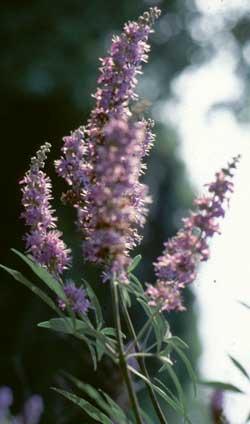By Steven Horne and Paula Perretty

Native to western Asia and southwestern Europe, chaste tree, also known as monk’s pepper or vitex, has been used to treat hormonal imbalances for more than 2,500 years in Egypt, Greece and Rome. It gets its name from its use by monks during the middle ages to help reduce sexual desire. Also known as vitex, it helps to balance the output of reproductive hormones in both men and women.
The berries of chaste tree have been historically used for reproductive problems like cyclic breast discomfort (cyclic mastalgia), heavy menstrual bleeding, PMS and menopause. Modern research has documented many of these benefits resulting in chaste tree berries being approved by the German E Commission for these uses. As a result, it is widely used by family physicians and gynecologists in Germany.
The reproductive functions of the ovaries and testes, as well as numerous other metabolic functions, are regulated by the hormones of the anterior pituitary gland. Chaste tree’s therapeutic effects are attributed to its indirect effects on various hormones secreted by the pituitary gland. It helps to regulate and balance levels of prolactin, estrogen and progesterone, making it primarily useful as a remedy for women.
Chaste tree does not actually contain hormones or even hormone-like substances. Its action is indirect, but does appear to be dose-dependent. Low doses of chaste tree result in decreased estrogen levels and an increase in levels of progesterone and prolactin. It appears to inhibit the release of follicle-stimulating hormone (FSH) while stimulating the production of luteinizing hormone (LH).
However, in some studies where women were given larger doses, FSH and LH levels remained unchanged, while prolactin levels were decreased. Prolactin stimulates breast milk production, so this helps to explain why low doses of chaste tree can stimulate breast milk production, whereas higher doses seem to have the opposite effect. The ability to decrease mildly elevated prolactin levels may benefit some women with breast tenderness associated with PMS.
The bottom line is that chaste tree berries help restore a normal estrogen-to-progesterone balance, as well as keeping prolactin in check. Studies also show that vitex can stabilize the cycle after withdrawal from progesterone birth control pills. It is also a useful remedy for irregular menstrual cycles and teenage acne due to hormonal issues. Fourth generation herbalist Christopher Hobbs says he has cleared up many cases of teenage acne with chaste tree alone.
Chaste tree berries are found in the formula Wild Yam & Chaste Tree which is used for menstrual cramping, irregular menstrual cycles and balancing excess estrogen and deficient progesterone. Chaste tree berries are also part of Menstrual Reg, a formula for heavy menstrual bleeding and DHEA-F which supports female adrenal and reproductive hormones.
Selected References
- Chasteberry by Beatrix Roemheld-Hamm, M.D., PH.D., University of Medicine and Dentistry of New Jersey-Robert Wood Johnson Medical School, New Brunswick, New Jersey in the American Academy of Family Physicians (2005).
- Chaste Berry by David L. Hoffmann B.Sc. (Hons), M.N.I.M.H.
- PDR for Herbal Medicines published by Medical Economics Company.
- Herbs Demystified: A Scientist Explains How the Most Common Herbal Remedies Really Work by Holly Phaneuf.

